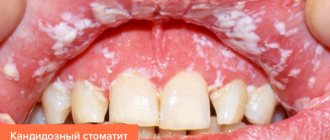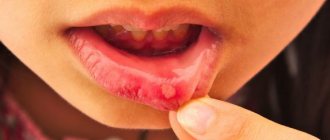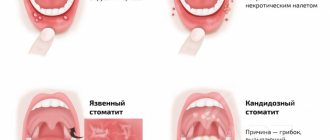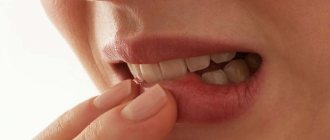Aphthous stomatitis is an acute inflammation of the oral mucosa with the formation of painful erosions (aphthous). Small round ulcers form on the inside of the lips, cheeks, tongue, tonsils, cause constant pain and affect overall well-being. Stomatitis is caused by a viral or bacterial infection, microtrauma of the mouth. But most often the disease develops against the background of stress or a decrease in the body’s defenses.
What is aphthous stomatitis
The exact mechanisms of development of aphthous stomatitis are still unknown.
It is generally accepted that with aphthous stomatitis, the infection enters the oral cavity, but does not cause a protective reaction in the body's immune cells. They simply do not recognize the pathogen. The infection changes the composition of saliva, this causes the activity of lymphocytes and the immune system attacks areas of the oral mucosa as a foreign chemical agent.
As a result of this confrontation, erosions form on the mucous membrane.
Aphthae have a round or oblong shape with a diameter of up to 5 mm. Outwardly, they resemble ulcers, covered with a white or gray coating and outlined with a red rim. On the mucous membrane, aphthae are located in groups or separately.
If more than three canker sores have formed in the mouth, this is a severe form of stomatitis. Despite their small size, the ulcers are painful and interfere with eating and talking. With stomatitis, the temperature may rise and weakness may appear.
If a person's immune system is weak, it will continue to interpret the presence of foreign chemicals in the mouth as a danger and canker sores will become chronic. Therefore, it is important to start treatment of aphthous stomatitis on time and carry it out under the supervision of a doctor.
Diamond green
Zelenka is an old, proven antiseptic that has been used for more than one generation. It is almost impossible to meet her abroad, since when treating patients in Europe and the USA, it is customary to pay attention to the aesthetic side of treatment. Patients in green dots, according to Western doctors, look scary, and the patients themselves are not happy with such a drug.
Zelenka has a number of advantages compared to other antiseptics. It has a milder effect, which is ideal for treating young children. It does not leave scars and does not dry out the skin.
The drug contains two components: brilliant green and ethanol. The solution contains no contraindications for use, however, if it comes into contact with the mucous membrane of the eye, it can cause a burn.
Causes of aphthous stomatitis
Aphthous stomatitis can be an independent disease or develop as a result of complex causes. Among them:
- Using aggressive agents that dry out the oral cavity (for example, sodium lauryl sulfate) during daily oral hygiene. The mucous membrane becomes more vulnerable, especially to sour and pungent tastes, and ulcers easily form on it.
- Mechanical damage to the oral cavity. Accidental biting of the inner surface, scratches from fillings and dentures, sharp chips of a tooth, rough traumatic food violate the integrity of the mucous membrane, and the resulting ulcer can serve as the beginning of the disease.
- Nervous tension and stress.
- Unbalanced nutrition, diets, nutrient and mineral deficiencies. Particularly critical is the lack of iron, zinc, folic acid, selenium, and vitamins B and C.
- Allergy to food. Products with gluten (flour), apples, tomatoes, chocolate, seafood and some food additives are critical.
- Menstrual cycle in women. Codependency with aphthous stomatitis is observed in only 10–15% of cases.
- Genetic predisposition.
- Chronic blood diseases, gastrointestinal tract, immunodeficiencies.
- Long courses of taking nonsteroidal drugs, medications for arrhythmia and high blood pressure.
Zelenka: indications for use
Since brilliant green has shown itself to be an active antiseptic, it began to be used in the treatment of wounds and abrasions. Later it turned out that applying the solution to ulcers and acne of bacterial origin reduces the severity of the rash, and soon completely clears the skin of papules.
In this regard, brilliant green is used for:
- mechanical damage to the skin (abrasions, cuts, deep wounds);
- rashes caused by insect bites, in particular mosquito bites;
- weeping allergic rash;
- chickenpox infection;
- fungal infections of the mucous membranes;
- the threat of joining and spreading superinfection.
Zelenka, in addition to its ability to destroy pathogenic flora, also has a drying effect, so it is often used for weeping rashes and wounds.
The solution is used strictly topically; it is not intended for oral administration. Zelenka is used to treat the edges of deep wounds; it is applied to abrasions, covering, if possible, the entire damaged surface. For rashes, use brilliant green in a targeted manner, applying it only to the papules with a cotton swab.
Is stomatitis contagious?
Canker sores can be contracted if the condition is caused by a virus, fungus, or infection. The pathogen is easily transmitted through shared objects and airborne droplets.
Children are especially susceptible to infectious stomatitis - due to their age, the mucous membranes of the oral cavity have not yet formed the required level of protection. Aphthous stomatitis is especially severe in infants, including those with damage to internal organs. Adults have a chance of getting sick only when they have microcracks or abrasions in the mouth.
Fungal stomatitis is transmitted through water, dishes, and food.
Stomatitis that develops as a result of vitamin deficiency, stress or mechanical trauma is not contagious.
How to use
To treat the affected surface, you will need cotton swabs, which are used for ears, or cotton swabs. They are dipped in a solution of brilliant green and gently lubricated on the affected areas of the skin. The green stuff should be only one percent. The procedure is usually carried out twice, that is, after one application of the solution, the second immediately follows. After treatment, the mouth is not closed for some time, but kept open to dry the wounds.
Side effects of this treatment include a burning sensation or tingling sensation. Sometimes children have difficulty with this procedure. Because of this, adults begin to doubt whether it is possible to cauterize stomatitis with brilliant green. Parents should be patient and calm the baby. The unpleasant sensation passes quite quickly. Children most often do not need to re-apply the drug.
The course of treatment can last from one week to two for an adult and about five days for a child. Reviews of brilliant green for stomatitis in children are always very positive.
Symptoms of the disease and its complications
Aphthous stomatitis does not begin with the formation of ulcers. The stages of the disease are:
- The lymph nodes become inflamed, the temperature rises and general weakness occurs.
- Small blisters form in the mouth, which spontaneously open and turn into aphthae.
- Salivation increases.
- At first, it is unpleasant for the patient to eat food with a pronounced taste, and then chewing any food causes pain.
- With a persistent form of aphthous stomatitis, the lymph nodes become inflamed and become painful on palpation.
- The mucous membranes of the mouth are loose and inflamed.
- A white coating appears on the tongue.
- At the final stage of the disease, aphthae scar, and soreness in the mouth disappears.
If the patient has not received adequate treatment, aphthous stomatitis becomes chronic. Wherein:
- The mucous membranes swell and turn pale.
- Aphthae grow and cover the inner surface of the cheeks, palate and back of the tongue. In advanced forms, the ulcers rise above the surface of the oral mucosa.
- Without receiving proper treatment, the growth of ulcers resumes every two weeks. The wounds bleed and penetrate deeper into the tissues of the mouth.
- When healing, erosions leave deep scars.
Processing technique
The oral cavity in case of stomatitis in a child is usually treated as follows: the baby is seated in such a way that there is some kind of lighting nearby. Next, one adult holds his legs, and the second fixes the torso, grabbing the child with one hand. Place a palm on the baby's forehead and ask him to open his mouth wider. If the procedure is performed on an infant, the parent opens his mouth slightly using a teaspoon.
The hands of the person who will perform the procedure must be gloved. The cotton stick is held like a pen for writing. First, they are carried along the oral cavity to the teeth, and then they are turned over and carried along the lateral surface of the gums. Be sure to apply a small amount of product to the tongue.
These simple manipulations are used to treat a child’s mouth. An adult calmly applies antiseptic to the mucous membrane on his own, using cotton swabs. For stomatitis in adults, brilliant green, as a rule, does not cause such side effects. They endure the procedures throughout the entire course.
Patients are much more confused by the aesthetic side of such treatment. After all, going to work or school with a green mouth is not the most pleasant experience. For those who doubt whether it is possible to smear stomatitis with brilliant green, you can use any other means.
Classification and forms of the disease
According to the nature of the disease, stomatitis can be:
- Spicy . The appearance of painful ulcers in the mouth is accompanied by fever. The disease lasts 2–3 weeks;
- Chronic . The disease progresses in waves, with periods of long lulls and rare exacerbations. Lasts up to 2–3 years.
According to the type of pathogen, stomatitis is:
- Viral . Its causative agent is the herpes virus. It causes bubbles of clear liquid to appear. After the bubbles burst, aphthae remain in their place.
- Radial . If the mucous membrane is irradiated by ionizing radiation, compactions and erosions may occur.
- Fungal . Occurs when immunity decreases or a shock dose of antibiotics. A powdery coating forms on the seals of the mucous membrane, and when you try to remove it, the aphthae is exposed.
- Bacterial . Caused by streptococci and staphylococci. The whole process goes quickly - ulcers are actively formed, aphthae quickly stop hurting and heal.
- Chemical . This is the result of burns to the mouth from acids or alkalis. In this case, deep ulcers are formed and the tissue is deformed.
Depending on the type of pathogen, several forms of acute stomatitis are distinguished:
- Fibrinous. In the initial stage, rashes appear no more than 1–3 times a year during exacerbations of systemic diseases or microtraumas of the mouth. Small blisters covered with fibrous plaque are located on the inner surface of the lips, tongue, and cheeks. They scar after 1–2 weeks. If the cause of the disease is not treated, aphthae form more and more often and cover large areas.
- Necrotic. Typical for patients suffering from severe chronic pathologies. In this case, aphthae become a consequence of the death of the epithelium. In the initial stage, aphthae are painless, but then develop into ulcers that do not close within a period of several weeks to a month.
- Gradular . It develops when the salivary glands are damaged, and aphthae develop next to them. The ulcers are painful and take 1 to 3 weeks to heal, after which the ulcers reopen.
- Scarring. Aphthae cover the mucous membrane of the mouth near the salivary glands, pharynx and palate. At first they are small in size, but quickly unite into deep painful ulcers with a diameter of up to 1 centimeter. They heal slowly (up to 3 months) and form scars.
- Deforming. The most severe form of aphthous dermatitis. Aphthae grow deeply into the mucous membrane and, when healing, form rough scars that deform the oral cavity. Deforming stomatitis is the most difficult to treat; recovery will take at least 2 months.
- Herpetic . Consequence of infection by the herpes virus. Up to 30 small ulcers simultaneously form on the mucous membrane, the tissues become inflamed and turn bright red. It is more common in infants who become infected with the virus in utero or during childbirth.
- Recurrent . Aphthae do not heal for a long time, merge with each other and form a large painful ulcer. The lesions become covered with a white coating, make it difficult to eat, and the person suffers from pain and burning. This form of stomatitis occurs only in adults.
In children, 2 forms are most often observed:
- Spicy . Children under 3 years old are ill, usually against the background of other infectious diseases - whooping cough, diphtheria, measles. In acute stomatitis, a lot of saliva is released, the smell from the mouth is unpleasant, putrefactive.
- Mixed. They appear in children over 4 years of age and cause frequent relapses. In this case, the disease affects an increasingly larger area each time.
Treatment of mucosal inflammation
Depending on the nature of the disease, stomatitis will be treated. For example, if it is caused by bacteria, then antibacterial drugs will be needed. As an additional treatment, wound healing agents containing vitamin A and E are necessarily used. Sea buckthorn oil, chamomile or wild rose oil are most often used. Propolis and honey have also proven themselves to be excellent.
Doctors advise rinsing with decoctions of chamomile, oak bark, St. John's wort or calendula. Herbs are brewed at the rate of two tablespoons per 0.5 liters of hot water. As soon as the decoction is infused, it is filtered and used throughout the day. As a rule, a half-liter jar is enough for one day.
Oak bark is brewed only in a water bath or over open low heat. If desired, you can prepare the decoction for 2 days, provided that it is stored only in the refrigerator. The product is heated before use.
Diagnosis of the disease and its differences from other pathologies
The doctor receives the first data after examining the patient’s mouth. Next, the doctor collects an anamnesis of the disease and the patient must answer when the first symptoms appeared, how quickly the disease developed, whether there were injuries (including burns) to the oral cavity, allergies to foods and medications, whether close relatives suffered from stomatitis.
To identify the causative agent of the disease, you will need to take a smear on the flora and exclude manifestations of herpes and candidiasis. For this purpose, laboratory tests are used - bacterial culture and PCR smear.
For persistent stomatitis, you should check your blood glucose level.
Why use brilliant green for chickenpox?
Chickenpox is an infectious disease caused by chickenpox. This is a type of herpes virus. The disease manifests itself as specific rashes on the skin. The elements of such a rash contain fluid under the skin; rupture of the papule is dangerous for infection, therefore it is highly undesirable.
It is not difficult to recognize a child suffering from chickenpox - he is usually covered with brilliant green. Since the prosperity of Soviet medicine, it has been customary to treat each papule with brilliant green, despite the fact that this process has nothing to do with the direct treatment of chickenpox.
Chickenpox is caused by a type of herpes virus that acts from the inside. The appearance of a rash indicates that the body has begun to fight the pathogen. Dead microbes release toxins, which in turn cause a rash. It is by the nature of the rash that you can determine whether the disease is progressing or not. This is exactly what brilliant green is used for.
While the immune system fights the virus, new elements of the rash appear. Zeleka, due to the fact that it is not washed off from the skin for a long time, helps to monitor the appearance of new papules. As soon as new elements stop appearing, you can start counting 9 days, after which the patient ceases to be infectious.
In addition to its marking function, brilliant green has a certain protective effect. It is due to the fact that the chickenpox rash is watery. If a patient sweats profusely due to high temperature, the skin begins to itch. It is easier for an adult to endure and not itch than for a child. Young patients quickly succumb to instinct and scratch the rash, subcutaneous fluid comes out, and the closed vesicle becomes an entry gate for a bacterial or fungal infection.
Zelenka, having a drying effect, prevents severe itching, and also disinfects already opened elements of the rash. Pediatricians say that to prevent itchy skin, the child needs to be washed. The prohibition against swimming in case of chickenpox applies exclusively to prolonged stay in water. This suggests that you should not put your child in the bath for 15-20 minutes. But after sweating due to hyperthermia that often occurs, it must be washed with soap to remove sweat, salt and sebum from the surface of the skin.











